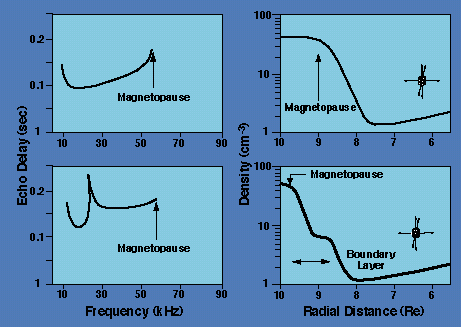Understanding the physics of magnetospheric substorms remains a high priority in modern space physics. In this section, we will examine only one aspect of substorm dynamics in which IMAGE will be able to increase our understanding.
In situ and auroral imaging observations in the past have provided a wealth of information on substorm related processes but mostly in localized regions which are then correlated in time. These observations, however, have yielded little information on how substorm processes occurring in the magnetosphere are connected to the structures and dynamics of the outer magnetospheric boundaries, the boundary layers and the magnetopause, which are directly coupled to the solar wind and interplanetary magnetic field.
In a recent paper, Lui et al. [1989] have shown from Viking UV images of the auroral zone that spatially periodic bright spots are frequently seen in the dayside auroral oval in the 1400-1600 MLT sector, and sometimes in the pre-noon sector. These auroral features, having time scales varying from 1 to 10 minutes, often occur within substorm intervals but sometimes without concurrent substorm activities [Lui et al., 1987]. Furthermore, these apparently localized and transient auroral activities also exhibit rapidly varying intensities and motions. Such activitieshave been interpreted as unrelated to the possible impulsive plasma entry from the magnetosheath [Lemaire, 1977], but to the Kelvin-Helmholtz surface waves that may be unstable in the boundary layers [Sandholt et al., 1986].
Figure 2, adapted from Lui et al. [1989], shows the possible association between the daytime auroral bright spots and the surface wave structure in the boundary layer. However, the extent of the role of the boundary layer structure in substorm processes is not clear [Potemra et al., 1990]. IMAGE will provide the first opportunity to observe both the substorm related auroral activities and the boundary layer structure and dynamics simultaneously, and thus will advance our understanding of the connection between the outer magnetospheric boundary and the inner magnetosphere.

Figure 2. A schematic adapted from Lui et al. [1989] which shows the possible connection between structures in the boundary layer and substorm auroral activity (lower left). The lower right panel (from Reiff et al. [1996] shows an RPI image of a boundary layer surface wave in which the narrow and wide lobes correspond to the crest and trough regions of the wave, respectively.
The importance of auroral imaging in substorm studies has been demonstrated repeatedly by using the Dynamics Explorer 1 and the Swedish Viking satellite data in such investigations [Frank and Craven, 1988; Shepherd et al., 1987; 1990]. The FUV imager on IMAGE will provide the necessary auroral images concurrent with other measurements by the NAI, RPI and EUV imagers.
During a substorm or storm interval, global distributions of He+ in the inner magnetosphere will be obtained by the EUV imager in sequences of two-dimensional, line-of-sight images. RPI measurements will then be used to identify internal plasmaspheric density structures such as biteouts, closely wrapped tails, or the field-aligned density structures, which would otherwise be obscured in integrated EUV images. Ring current images from the NAI will identify ring current plasmaspheric interactions. In addition, the RPI measurements in both the ordinary and extraordinary modes arriving from the boundary layer and the plasmasphere-ring current region will complement the NAI images [Fung and Green, 1996]. The entire set of images from the various instruments will then be placed in context with magnetospheric activity through FUV observations of auroral morphology.

Figure 3. Simulated NAI observations (right panel) of a magnetic storm (left panel) based on the observations of a May storm (courtesy of Mei-Ching Fok).
Figure 3 shows computer simulation of the IMAGE NAI observations of a magnetic storm. Based on observations of the May 1996 magnetic storm, the neutral atom fluxes and the corresponding simulated NAI image counts for 63+/-35 KeV Hydrogen during the main phase of the storm have been calculated and displayed in the left and right panel respectively. The viewpoint is from dusk with the sun to the left. The assumed instrument response characteristics are summarized at top right. Rather coarse pixels are used here to obtain good statistics with relatively short exposure.
Using the RPI measurements, instantaneous locations of magnetospheric boundaries (magnetopause and plasmapause) and density profiles along a given radio echo ray path can be obtained by inverting the plasmagram trace. This technique has been applied successfully to obtain the plasma structure of the ionosphere. The right panels in Figure 4 show two distinct density profiles which may occur in the boundary layer and magnetopause under different solar wind and interplanetary magnetic field conditions. The left panels in Figure 4 depict the corresponding simulated plasmagrams. It is noted that internal structures of the boundary layer will likely lead to distinctive features in the resulting plasmagram, analogous to the case of ionospheric sounding.

Figure 4. Simulated RPI plasmagrama (left panels) and possible density profiles in the boundary layer and magnetopause regions (right panels).